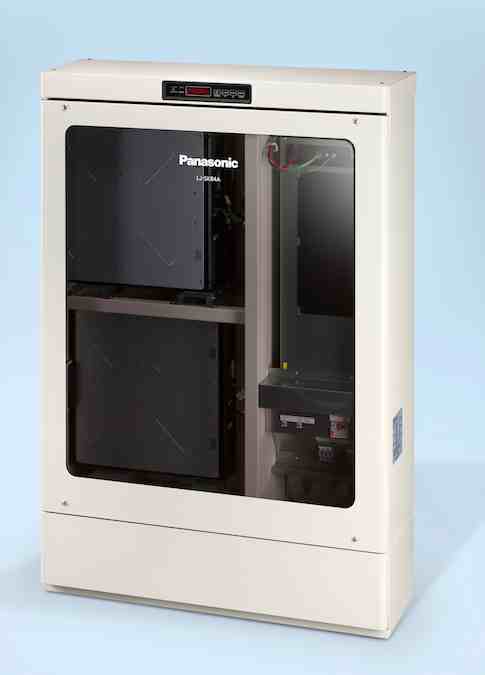See also how Panasonic battery storage will force utilities to change business models.
Japanese electronics giant Panasonic has struck agreements with three Australian energy utilities to trial its home-based battery storage options, saying it would help double the amount of self-consumption of Australian solar households and also challenge utilities to change their business models.
 Panasonic has agreed on trials with Red Energy, the retailing arm of the mostly NSW government-owned Snowy Hydro, along with Queensland regional network operator and retailer Ergon Energy, and the ACT-based utility ActewAGL.
Panasonic has agreed on trials with Red Energy, the retailing arm of the mostly NSW government-owned Snowy Hydro, along with Queensland regional network operator and retailer Ergon Energy, and the ACT-based utility ActewAGL.
The Japanese company says the 8kWh lithium-ion battery storage system, with an output of 2kW, has been designed specifically for the Australian market. It says it will best suit solar arrays of around 5kW.
Panasonic says the system will help solar households double their rates of self consumption from around 30 per cent to 60 per cent, by storing excess solar output during the day for use later.
This, it says, will provide “a reliable, efficient base load for solar installed households during peak periods”.
Panasonic is one of a number of international and local battery technology developers targeting Australia, which, because of its high electricity prices, great solar resource and its world-leading penetration levels of household solar, is considered one of the most prospective markets in the world.
Katsufumi Miyamoto, the head of strategic planning for energy systems at Panasonic, told RenewEconomy in an interview that Australia will lead the world in battery storage, and the development of new business models for retailers and network operators.
Apart from a backup storage system designed for the Japanese market, Australia will be the first international market that it will tackle.
But Panasonic’s approach is different to others. While most battery storage developers are targeting individual households and will sell direct to consumers, Panasonic is looking to sell only through retailers and network operators.
That’s the intent of the trials with Ergon, ActewAGL and Red Energy. The trials will last two years, but Panasonic expects data to provide enough information within two months. It will begin its sales channel by October and all utilities involved say they expect to sell to their customers at that time.
Paul Reid, the managing director of Panasonic Australia, says the system will include demand response technology and remote charge and discharge programs which can be used by retailers and network operators.
For instance, the use of a utility’s server could aggregate up to 20,000 individual solar systems, or provide a total of 40MW capacity to deal with loads at peak time. “There is potential for them to access large volumes of energy at any particular time,” Reid says.
Reid says the key to battery technology will be its ability to deliver value, not just to consumers, but to retailers and networks as well.
“The consumer is central to this, but if we can deliver a win, win, win situation – a win to the consumer, a win to the network, and a win to the retailer, this will be a different proposition to other off the shelf products,” he said.
Panasonic will not be drawn on the price of its technology, nor on the potential uptake. It does, however, say that it will not be the cheapest in the market.
“The market potential is enormous,” Reid says. “Not all of Australia’s 1.4 million residential battery storage installations are the right size, but over time the potential is substantial.”
The 5kW optimum size for solar systems corresponds roughly with the size of new systems being installed in Australia, although because of small systems installed in early years the average size is still below 4kW.
On costs, Miyamoto said, cell technology was already well advanced. Panasonic has made 10 billion lithium-ion battery cells for a range of applications, provides the battery cells for the Tesla Model S electric vehicle, and is the partner and cell provider for Tesla’s Gigafactory.
But the balance of systems costs, the modules and other associated technologies such as battery inverters, would offer future cost savings, which will be accelerated by scale of production and competition.
Ergon Energy, which is trialling a range of battery storage systems, both at the network and residential level, says its system will be tested initially at an Ergon research laboratory in Cairns, using homes to gather ‘real world’ understanding of how such systems can benefit customers and interact with the electricity network.
“Changing social trends and technological advances, particularly cost reductions in solar PV systems and now battery energy storage systems, will dramatically change – even revolutionise – the way electricity is supplied to and used by our customers,” said Ergon’s manager of emerging markets, Glenn Walden.
“Battery storage has the potential to provide residential customers with greater choice and control of energy use and could make our electricity network cheaper to operate in the long term,” Walden said.
“It can allow solar energy produced during the day to be used at peak load times in the evening or energy to be stored at light network load times and supplied at heavy load times,” he said.
Red Energy says it will use Panasonic as its sole provider for battery storage. Paul Broad, the CEO of parent company Snowy Hydro said battery storage will complement its hydro-electric storage system. “This trial will help us understand how … we can provide Australians with even more clean, green energy,” he said in a statement.
See our separate analysis, how Panasonic battery storage will force utilities to change business models.
Disclosure: The author’s air travel to Sydney was provided by Panasonic.











